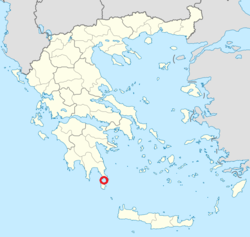Pavlopetri

The city of Pavlopetri, underwater off the coast of southern Laconia in Greece, is about 5000 years old, and is the oldest submerged archeological town site. It is unique in having an almost complete town plan, including streets, buildings, and tombs. It was discovered in 1967 by Nicholas Flemming and mapped in 1968 by a team of archaeologists from Cambridge.
It has at least 15 buildings submerged in three to four metres of water. The newest discoveries in 2009 alone cover 9,000 square meters.[1][2]
Earlier, the ruins were dated to the Mycenaean period, 1600-1100 BCE. Later studies showed an older occupation date starting no later than 2800 BCE, so it also includes early Bronze Age middle Minoan and transitional material.[3]
It is now believed that the town became underwater around 1000 BCE.[4] The area never reemerged, so it was not built over nor disrupted by agriculture.
Although eroded over the centuries, the town layout is as it was thousands of years ago. The site is currently being damaged by boats dragging anchors, tourists and souvenir hunters.[5][6]
2009's fieldwork was largely to map the site. It is the first submerged town digitally surveyed in three dimensions.[2] Sonar mapping techniques developed by military and oil prospecting organizations have aided recent work.[7]
As of October 2009, four more fieldwork sessions are planned, also in collaboration with the Greek government as a joint project. Those sessions will do excavations. The research is to be published in full in 2014.
References
- ^ Henderson, Jon (2009-10-16). "World's oldest submerged town dates back 5,000 years". University of Nottingham. Retrieved 2009-10-24.
- ^ a b Henderson, Jon (2009-05-12). "Race to preserve the world's oldest submerged town". University of Nottingham. Retrieved 2009-10-24.
- ^ "World's oldest submerged town dates back 5,000 years". Paleontology & Archaeology. e! Science News. 2009-10-16. Retrieved 2009-10-24.
- ^ Helena Smith (October 16, 2009). "Lost Greek city that may have inspired Atlantis myth gives up secrets". The Guardian.
- ^ Henderson, Jon (2009-05-14). "Race to Save World's Oldest Underwater Town". Green Room Blog. WetSand.com. AlphaGalileo. Retrieved 2009-10-24.
- ^ Henderson, Jon (2009-05-12). "Race to preserve the world's oldest submerged town". AlphaGalileo. Retrieved 2009-10-24.
- ^ BBC News "Sea gives up secrets to experts", 16 October 2009; accessed 16 October 2009.
